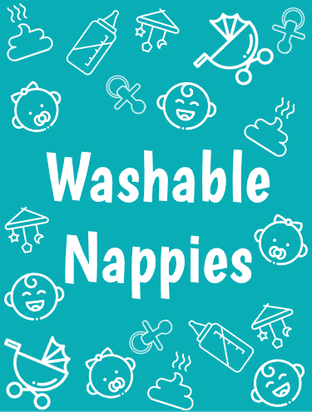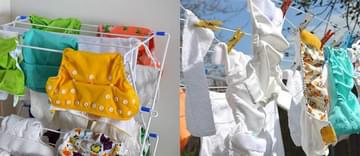

Top Tips for a Successful Reusable Nappy Journey
Top Tips for a Successful Reusable Nappy Journey
Useful things like making sure the fit is right, washing and drying, poo, dealing with stains, avoiding leaks, dressing the cloth bum and how to use washable nappies out and about and at night time
Top Tips for a Successful Reusable Nappy Journey
- As one of the first things, prepare your nappy bucket for the dirty nappies and always prepare the nappies for the wash straight away. This will save you from going through the dirty pile when you are ready to do your laundry.
- As reusable nappies are very flexible, use poppers, velcro, boosters and liners to adjust the nappy to your baby’s size, shape, poo and wee.
- Extra boosters can increase the absorbency of your nappy but also make it bulkier. Try all-in-ones with the provided inserts only and see if it is enough. It is all about trying different combinations and finding the one that works for your baby.
- Bamboo nappies and boosters are highly absorbent and slim, so if you have a heavy wetter and want maximum absorbency, these might be a good option to avoid getting a super bulky nappy. But keep in mind that bamboo also takes longer to dry than cotton or microfiber.
- If you want your little one to use disposables at childcare, just speak with them. A lot of nurseries and childminders are happy to use them as long as you provide them. If they are not very experienced with them, all-in-ones might be a good choice as they are the most similar to disposables.
Some of the most common reasons for leakages with reusable nappies are fitting the nappy correctly, clothes being too tight (use a vest extender for this), or the nappy being simply full. Also, keep in mind that barrier creams such as Sudocrem and Bepanthen will restrict the moisture absorption of your nappy. Another factor is how new your nappy is - reusable nappies will increase in absorbency with every wash, so if you have only washed your nappy once or twice this might be the source of your leaks. Ideally, wash your reusable nappies a minimum of three times to ensure they are absorbent enough.
Here are a few fit tips to make sure this is not the cause of your leaks:
- On first wear with the birth to potty nappies, adjust the poppers going vertically down the nappy when it's being worn to get a snug fit.
- Do up the velcro or poppers so you can get 2 fingers down the front of the nappy.
- The back of the washable nappy only goes as high as the top of the bottom cheeks, then do it up, and if the top of the nappy at the front sits just under the tummy button, then it’s the right height.
- Make sure the nappy is in the creases of the legs; otherwise, the nappy will be really bulky and may leak.
- Ensure that no fabric is peeking out from the waterproof cover of the nappy.
- If your nappy leaks from just one place, it might be that it moved due to your baby moving. Try adding boosters or fold boosters to increase the absorbency in those places.

Once the nappy has been used just put it in the nappy bucket with the mesh bag in it. If the nappy fastens with Velcro fold the Velcro back onto the non-sticky part so the tabs don't attach to everything else in the wash. If the nappy has poo in it, there is no need to soak it first. As long as your baby has not started solid foods, just put the whole nappy, including the (water soluble) poo into the bucket.
If you are already on solid food, remove the more solid bits of poo before putting it in the bucket. You can do this in several ways – hold it under the toilet flush so that it washes some of it away, wipe it off with toilet roll, which can just be flushed or have a dedicated ‘poo spoon or spatula’ to scrape it off. Once your baby eats more solid food than milk, the poo is much firmer and will just slide off the nappy or reusable liner when held upright over the toilet. You can also use disposable liners as a top layer in the nappy to catch the solid poo, but please don’t flush them down the toilet (even if it says that’s fine on the packaging) and dispose of them in the bin.
Depending on your nappy, you might also want to take inserts out to ensure they wash properly and dry as quickly as possible. Once the bucket is full or after two days, take the mesh bag or wet bag and put it all (bag included) in the washing machine.
- Wash at either 40 or 60 degrees. We suggest using a prewash and washing at 60 if there are lots of poo nappies in the load.
- Use non-biological washing powder or liquid only. Please do not use biological washing products as these can damage some of the fabrics.
- You can wash nappies with other items. 60-degree wash and detergent will get the nappies and your clothes clean.
- Try to wash dirty nappies every 2 or 3 days. If you leave them longer than that, they’ll be rather smelly and might also be more likely to stain.
- DO NOT use fabric softener - this can reduce the absorbency.

Line dry, put over an airer or tumble dry on cool (hot drying can cause shrinking or other damage). NEVER put a washable nappy on to a direct heat source like a radiator.
Bamboo nappies and boosters will take longer to dry as they are very absorbent. For bamboo nappies, the drying time is similar to a pair of jeans. Microfiber/fleece will dry the quickest.
Sometimes poo stains are hard to remove. If they do not come out in the wash, then don't panic. Just wet the stain again and place the nappy in direct sunlight - on a washing line or windowsill for example. The sun fades the stain. It doesn't even need to be very sunny to work. This works well for clothing too.
Alternatively, there are also stain removers available that are suitable for a baby’s sensitive skin.
There is no evidence to suggest your baby is more likely to get nappy rash whether you use cloth nappies or disposable ones. Nappy rash is simply caused by poo being in contact with the skin for a period of time, and your baby may be more or less sensitive to it than other babies. Once you know your baby has pooed, change them as soon as you can and put a bit of nappy free time into every day if you can.
The only difference when treating nappy rash when you use washable nappies is that if you use a traditional barrier cream like Sudocrem or Bepanthen, it will stop your washable nappies from absorbing moisture. Instead, a moisturising cream should be used, e.g. coconut oil or Waitrose's Bottom Butter.
Some washable nappies are bulkier than disposables, especially if you have added lots of boosters. This can cause a few fitting issues with trousers and bodysuits. If your little one is just on the cusp of growing out of a size and you want to get the most from the bodysuit, then use vest extenders. With trousers, try what you have and see what fits. Just like with adult clothes, all brands fit slightly differently, but you have probably worked that out by now. You could also try tracksuit style bottoms rather than leggings.
You do not have to use washable nappies all the time. Many people choose to use disposables out and about and cloth at home. If you do want to give it a try away from the house here is what you need to do – put a nappy, (washable wipe if you are using them) and the wet bag into your changing bag. When you changed a nappy, just put the used one into the wet bag. Wet bags are great and can be used for anything that gets wet with sick, wee or poo.





